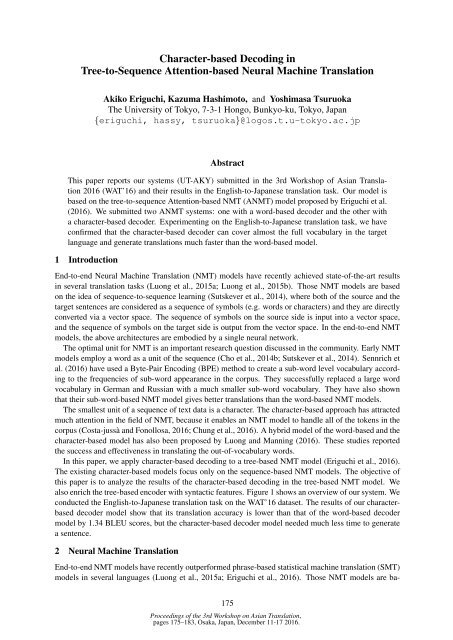December 11-16 2016 Osaka Japan
W16-46
W16-46
Create successful ePaper yourself
Turn your PDF publications into a flip-book with our unique Google optimized e-Paper software.
Character-based Decoding in<br />
Tree-to-Sequence Attention-based Neural Machine Translation<br />
Akiko Eriguchi, Kazuma Hashimoto, and Yoshimasa Tsuruoka<br />
The University of Tokyo, 7-3-1 Hongo, Bunkyo-ku, Tokyo, <strong>Japan</strong><br />
{eriguchi, hassy, tsuruoka}@logos.t.u-tokyo.ac.jp<br />
Abstract<br />
This paper reports our systems (UT-AKY) submitted in the 3rd Workshop of Asian Translation<br />
20<strong>16</strong> (WAT’<strong>16</strong>) and their results in the English-to-<strong>Japan</strong>ese translation task. Our model is<br />
based on the tree-to-sequence Attention-based NMT (ANMT) model proposed by Eriguchi et al.<br />
(20<strong>16</strong>). We submitted two ANMT systems: one with a word-based decoder and the other with<br />
a character-based decoder. Experimenting on the English-to-<strong>Japan</strong>ese translation task, we have<br />
confirmed that the character-based decoder can cover almost the full vocabulary in the target<br />
language and generate translations much faster than the word-based model.<br />
1 Introduction<br />
End-to-end Neural Machine Translation (NMT) models have recently achieved state-of-the-art results<br />
in several translation tasks (Luong et al., 2015a; Luong et al., 2015b). Those NMT models are based<br />
on the idea of sequence-to-sequence learning (Sutskever et al., 2014), where both of the source and the<br />
target sentences are considered as a sequence of symbols (e.g. words or characters) and they are directly<br />
converted via a vector space. The sequence of symbols on the source side is input into a vector space,<br />
and the sequence of symbols on the target side is output from the vector space. In the end-to-end NMT<br />
models, the above architectures are embodied by a single neural network.<br />
The optimal unit for NMT is an important research question discussed in the community. Early NMT<br />
models employ a word as a unit of the sequence (Cho et al., 2014b; Sutskever et al., 2014). Sennrich et<br />
al. (20<strong>16</strong>) have used a Byte-Pair Encoding (BPE) method to create a sub-word level vocabulary according<br />
to the frequencies of sub-word appearance in the corpus. They successfully replaced a large word<br />
vocabulary in German and Russian with a much smaller sub-word vocabulary. They have also shown<br />
that their sub-word-based NMT model gives better translations than the word-based NMT models.<br />
The smallest unit of a sequence of text data is a character. The character-based approach has attracted<br />
much attention in the field of NMT, because it enables an NMT model to handle all of the tokens in the<br />
corpus (Costa-jussà and Fonollosa, 20<strong>16</strong>; Chung et al., 20<strong>16</strong>). A hybrid model of the word-based and the<br />
character-based model has also been proposed by Luong and Manning (20<strong>16</strong>). These studies reported<br />
the success and effectiveness in translating the out-of-vocabulary words.<br />
In this paper, we apply character-based decoding to a tree-based NMT model (Eriguchi et al., 20<strong>16</strong>).<br />
The existing character-based models focus only on the sequence-based NMT models. The objective of<br />
this paper is to analyze the results of the character-based decoding in the tree-based NMT model. We<br />
also enrich the tree-based encoder with syntactic features. Figure 1 shows an overview of our system. We<br />
conducted the English-to-<strong>Japan</strong>ese translation task on the WAT’<strong>16</strong> dataset. The results of our characterbased<br />
decoder model show that its translation accuracy is lower than that of the word-based decoder<br />
model by 1.34 BLEU scores, but the character-based decoder model needed much less time to generate<br />
a sentence.<br />
2 Neural Machine Translation<br />
End-to-end NMT models have recently outperformed phrase-based statistical machine translation (SMT)<br />
models in several languages (Luong et al., 2015a; Eriguchi et al., 20<strong>16</strong>). Those NMT models are ba-<br />
175<br />
Proceedings of the 3rd Workshop on Asian Translation,<br />
pages 175–183, <strong>Osaka</strong>, <strong>Japan</strong>, <strong>December</strong> <strong>11</strong>-17 20<strong>16</strong>.



